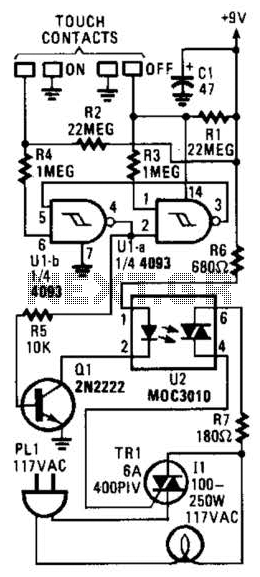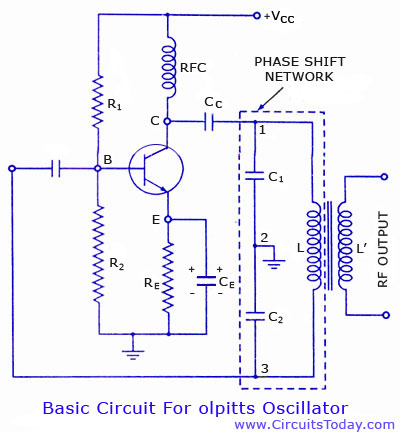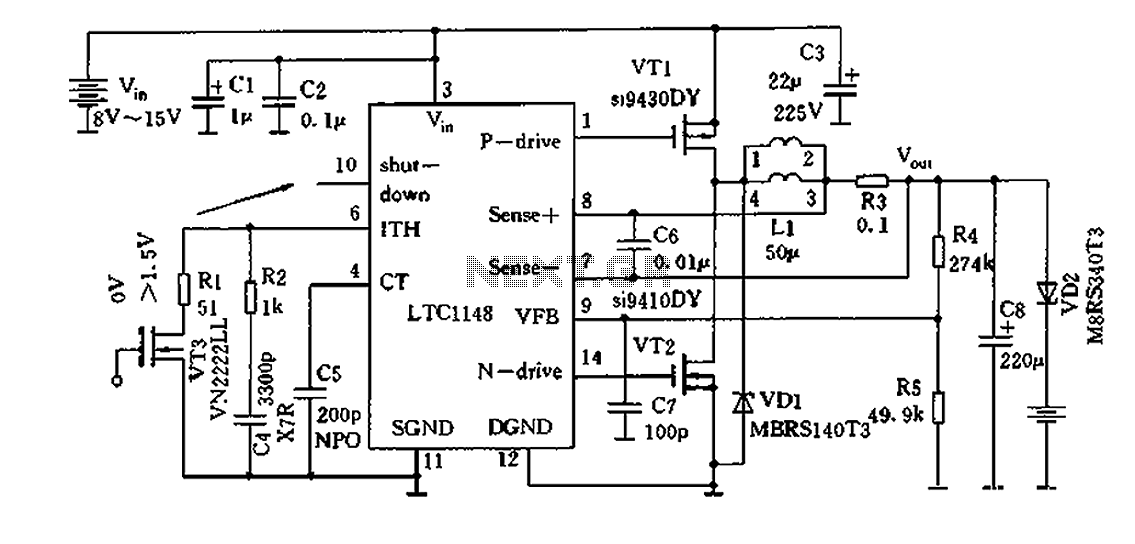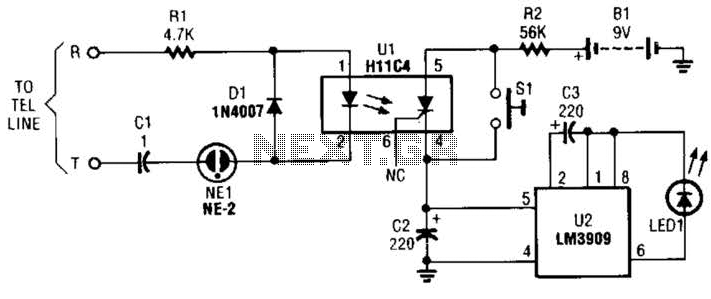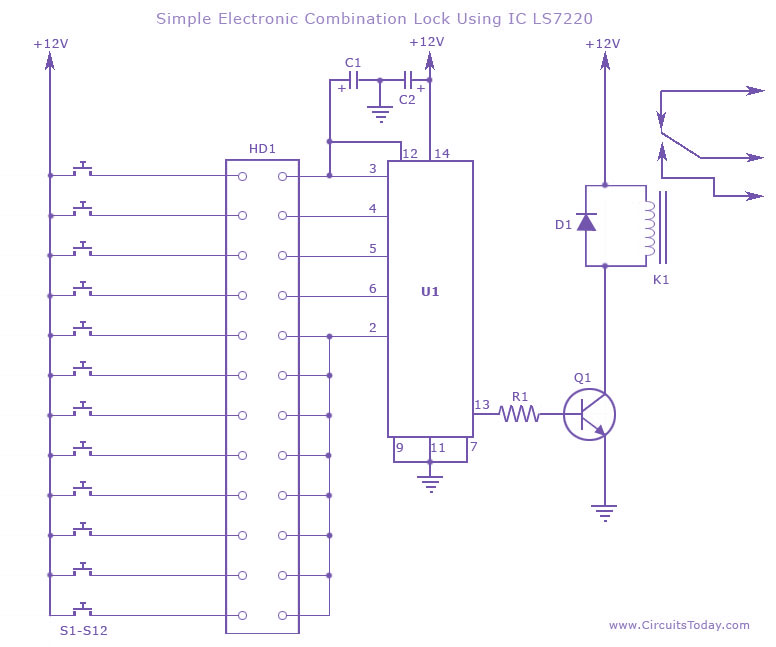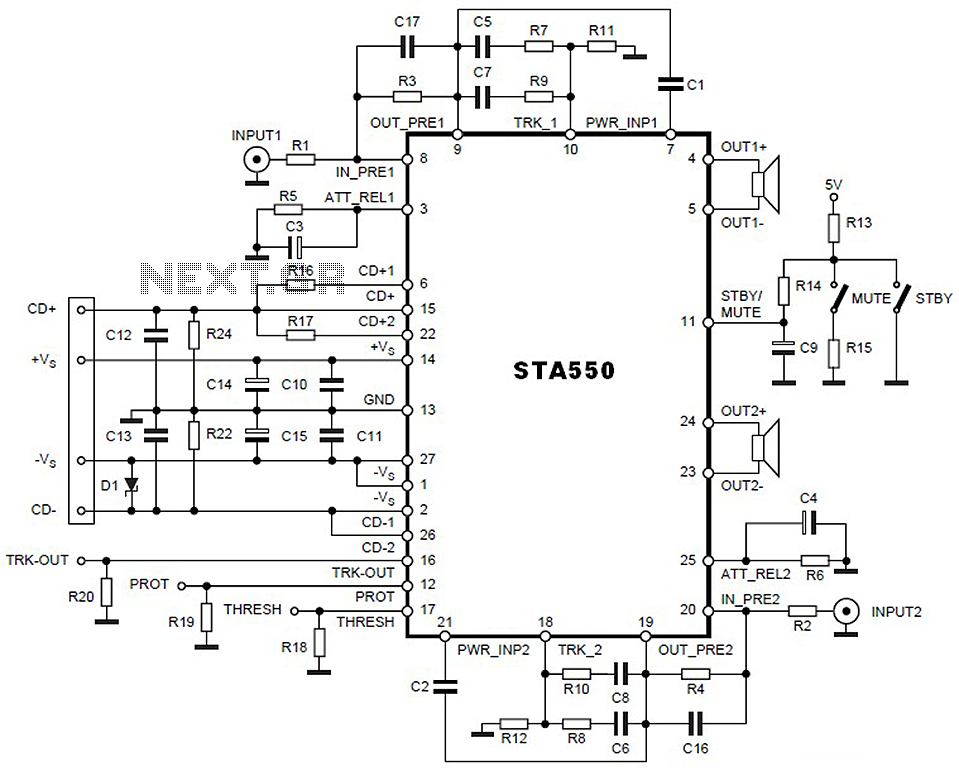
Press light switch double circuit 3
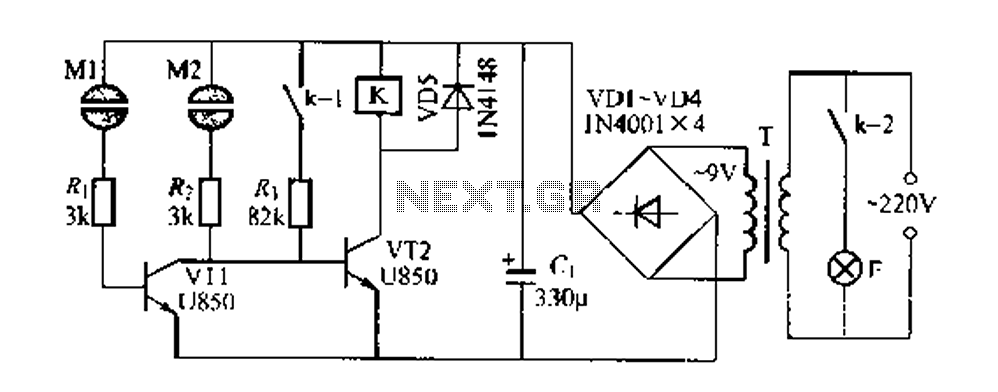
The Darlington circuit is a double-clamp touch switch circuit that features a touch-sensitive sheet and operates with a 20V AC mains supply through an isolated power transformer, ensuring relative safety. Once powered, a 20V optional AC transformer (T) is used along with a bridge rectifier (VD1-VD4) and a capacitor (C) for filtering, producing approximately 10V DC output for the Darlington circuit and a relay switch control circuit. In the initial state, both Darlington transistors (VT1 and VT2) are off, keeping the relay contacts (K1 and K2) open. When a finger touches the electrode sheet (M2), a DC voltage is generated, allowing base current to flow into VT2, which turns it on. This action energizes the relay, closing contacts K1 and K2, thus powering the electroluminescent lamp (F) and allowing current to flow through resistor (R). The circuit remains self-locked even after the finger is removed from M2 due to the current through R. To turn off the lamp, pressing the electrode sheet (M1) causes VT1 to saturate, which disables VT2, de-energizing the relay and opening contacts K1 and K2, turning off the lamp (E). The Darlington transistors are designed for high current gain, and while specific models may not be readily available, alternatives such as silicon diodes can be used in a composite configuration. The relay used is preferably a JZC-22F, a compact power relay with two changeover contacts rated for 2A. The circuit also includes a small power converter (Saikawa 220V/9V, 5VA). The touch electrode is constructed from a cut iron sheet shaped like a 2-cent coin, with a distance of about 1 inch between the electrodes, and is mounted in a plastic housing.
The Darlington touch switch circuit operates on the principle of capacitive sensing, where the touch-sensitive sheet detects the presence of a finger, allowing for a non-mechanical method of switching. The isolation provided by the transformer ensures that the low-voltage side of the circuit is safe for user interaction. The use of a bridge rectifier allows for efficient conversion of AC to DC, which is essential for the operation of the Darlington transistors that act as amplifiers for the base current.
The design of the circuit includes a self-locking mechanism, which means that once activated, the relay remains engaged until a specific action is taken to deactivate it. This feature is particularly useful in applications where a stable and continuous light source is desired without the need for constant interaction. The choice of components, such as the JZC-22F relay, is crucial for ensuring reliability and performance under varying load conditions.
The touch electrode's design is also significant; it is made from readily available materials, making it cost-effective and easy to fabricate. The size and shape of the electrode influence the sensitivity of the touch detection, and the distance between the electrodes is optimized for effective operation. The entire assembly is enclosed in a plastic housing to protect the components and ensure user safety.
Overall, the Darlington touch switch circuit presents an innovative solution for touch-sensitive control in various applications, combining safety, reliability, and ease of use in its design.Darlington is a tube made double clam touch switch circuit is characterized by a touch sheet and 20V AC mains through the power transformer T isolated, relatively safe. After t he circuit is powered, 2pOV Optional AC transformer T Buck, VDl-VD4 bridge rectifier and C. Filtering, mountain about 10V DC voltage output for the Darlington circuit and a relay switch control circuit electricity. Darlington VT1 and VT2 are in the OFF state state, two station contact K of relay point kl and k-2 are open, lights finger pressing a r electrode sheet M2, a DC voltage by a finger iL mesh l and to VT2 Tre eight base current, VT2 conduction, the relay station K was jU slow, contact k1, k2 closed.
Sheet 1. k-2 so that F Sh electroluminescent lamp, k1 resistor R. Access circuit so that when the circuit self-locking finger from the M2, since the R, WJ then. Relay still stays energized, spider F always light. Suddenly turn off the lights when needed, just use your fingers to press down electrical Almost sheet Ml, this time Darlington quickly saturated conduction VT1, VT2 ridicule the base grant the potential to make a sword fell off relay and zero electrical K release, its contact station k J, k2 jump thirty. IU lamp E goes out. VT1 and VT2 to adopt a very high number of peer River enlarged u850 Darlington diode, as the reader can not find such a pipe to be used in multiples of two release Gerbera type silicon NI 200 in 0014, N diode-connected into a composite pipe instead of Darlington s tube.
K preferably JZC-22F, 22 00 ultra-compact towel power relays, it has two changeover contacts, access point capacity 2A, line package r as voltage is OV. T Oh Saikawa 220V/9V, 5VA small power converter Lian device. The touch electrode made of iron sheet available canned cut into 2-cent coin size sheet-shaped paid, then cut from the Secretary, the distance of about 1n, tr.
Left and right, and then paste it in the plastic housing L ur.
The Darlington touch switch circuit operates on the principle of capacitive sensing, where the touch-sensitive sheet detects the presence of a finger, allowing for a non-mechanical method of switching. The isolation provided by the transformer ensures that the low-voltage side of the circuit is safe for user interaction. The use of a bridge rectifier allows for efficient conversion of AC to DC, which is essential for the operation of the Darlington transistors that act as amplifiers for the base current.
The design of the circuit includes a self-locking mechanism, which means that once activated, the relay remains engaged until a specific action is taken to deactivate it. This feature is particularly useful in applications where a stable and continuous light source is desired without the need for constant interaction. The choice of components, such as the JZC-22F relay, is crucial for ensuring reliability and performance under varying load conditions.
The touch electrode's design is also significant; it is made from readily available materials, making it cost-effective and easy to fabricate. The size and shape of the electrode influence the sensitivity of the touch detection, and the distance between the electrodes is optimized for effective operation. The entire assembly is enclosed in a plastic housing to protect the components and ensure user safety.
Overall, the Darlington touch switch circuit presents an innovative solution for touch-sensitive control in various applications, combining safety, reliability, and ease of use in its design.Darlington is a tube made double clam touch switch circuit is characterized by a touch sheet and 20V AC mains through the power transformer T isolated, relatively safe. After t he circuit is powered, 2pOV Optional AC transformer T Buck, VDl-VD4 bridge rectifier and C. Filtering, mountain about 10V DC voltage output for the Darlington circuit and a relay switch control circuit electricity. Darlington VT1 and VT2 are in the OFF state state, two station contact K of relay point kl and k-2 are open, lights finger pressing a r electrode sheet M2, a DC voltage by a finger iL mesh l and to VT2 Tre eight base current, VT2 conduction, the relay station K was jU slow, contact k1, k2 closed.
Sheet 1. k-2 so that F Sh electroluminescent lamp, k1 resistor R. Access circuit so that when the circuit self-locking finger from the M2, since the R, WJ then. Relay still stays energized, spider F always light. Suddenly turn off the lights when needed, just use your fingers to press down electrical Almost sheet Ml, this time Darlington quickly saturated conduction VT1, VT2 ridicule the base grant the potential to make a sword fell off relay and zero electrical K release, its contact station k J, k2 jump thirty. IU lamp E goes out. VT1 and VT2 to adopt a very high number of peer River enlarged u850 Darlington diode, as the reader can not find such a pipe to be used in multiples of two release Gerbera type silicon NI 200 in 0014, N diode-connected into a composite pipe instead of Darlington s tube.
K preferably JZC-22F, 22 00 ultra-compact towel power relays, it has two changeover contacts, access point capacity 2A, line package r as voltage is OV. T Oh Saikawa 220V/9V, 5VA small power converter Lian device. The touch electrode made of iron sheet available canned cut into 2-cent coin size sheet-shaped paid, then cut from the Secretary, the distance of about 1n, tr.
Left and right, and then paste it in the plastic housing L ur.
